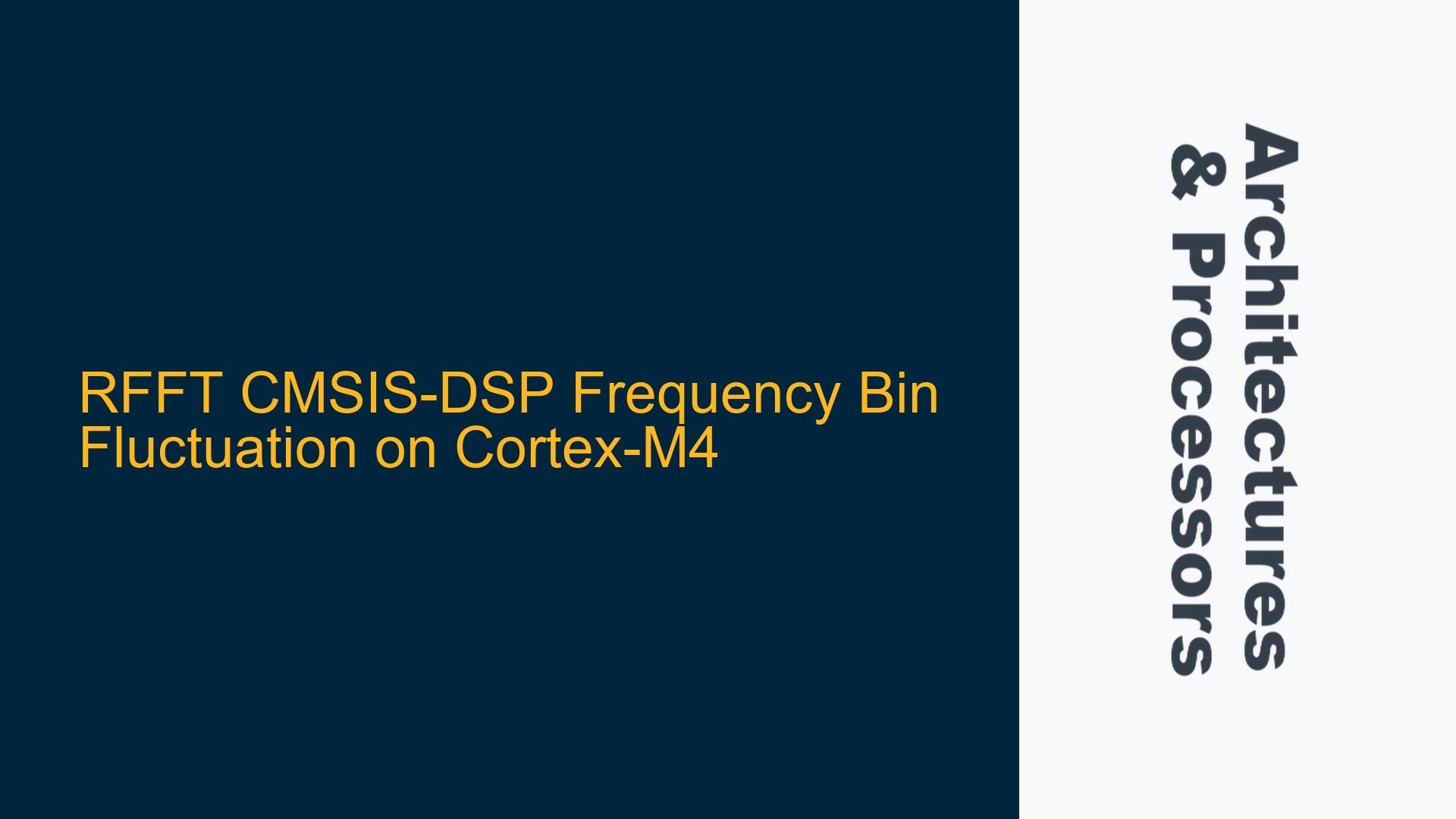ARM Cortex-M4 RFFT Frequency Bin Fluctuation During Sine Wave Analysis
The issue at hand involves the use of the ARM Cortex-M4 processor in conjunction with the CMSIS-DSP library, specifically the arm_rfft_f32() function, to perform a Real Fast Fourier Transform (RFFT) on a pure sine wave input. The input signal is captured via an external CODEC using SSI0 and uDMA for data transfer. The goal is to determine the frequency of the sine wave by identifying the maximum frequency bin from the RFFT output. However, the observed behavior is that the maximum bin index fluctuates between two adjacent bins, leading to inconsistent frequency calculations. This fluctuation is problematic for applications requiring precise frequency detection, such as audio processing or signal analysis.
The arm_rfft_f32() function computes the RFFT of a real-valued input signal and outputs an array containing alternating real and imaginary components. The user is only interested in the real components, so they extract these values into a separate array and use the max_arm_f32() function to find the bin with the maximum magnitude. Despite this extraction, the fluctuation between adjacent bins persists, indicating that the issue is not solely related to the separation of real and imaginary components.
This problem is particularly relevant for developers working with the ARM Cortex-M4 and CMSIS-DSP library, as it highlights a subtle but critical challenge in frequency domain analysis. The fluctuation in bin indices can lead to inaccurate frequency measurements, which may compromise the performance of the overall system. Understanding the root cause of this issue and implementing effective solutions is essential for ensuring reliable and precise frequency detection in embedded applications.
Memory Alignment, Quantization Effects, and Spectral Leakage
The fluctuation in the RFFT output bin indices can be attributed to several potential causes, each of which must be carefully examined to identify the root of the problem. These causes include memory alignment issues, quantization effects, spectral leakage, and the inherent limitations of the FFT algorithm.
Memory Alignment Issues
The ARM Cortex-M4 processor relies on efficient memory access patterns to achieve optimal performance. Misaligned memory access can lead to unexpected behavior, particularly when dealing with large data arrays such as those used in FFT computations. The arm_rfft_f32() function outputs an array with alternating real and imaginary components, which must be correctly aligned in memory to ensure accurate processing. If the memory alignment is not properly managed, it can result in data corruption or misinterpretation, leading to fluctuations in the bin indices.
Quantization Effects
Quantization effects arise from the finite precision of digital systems. The Cortex-M4 processor uses 32-bit floating-point arithmetic, which introduces rounding errors during calculations. These errors can accumulate during the FFT computation, particularly when dealing with high-precision frequency analysis. The quantization effects can cause small variations in the magnitude of the FFT output, leading to fluctuations in the identified maximum bin.
Spectral Leakage
Spectral leakage occurs when the input signal is not perfectly periodic within the analysis window. This results in the energy of the signal being spread across multiple frequency bins, rather than being concentrated in a single bin. In the case of a pure sine wave, spectral leakage can cause the energy to spill over into adjacent bins, making it difficult to accurately identify the true maximum bin. The windowing function used during the FFT computation can exacerbate or mitigate this effect, depending on its characteristics.
FFT Algorithm Limitations
The FFT algorithm itself has inherent limitations, particularly when dealing with non-stationary signals or signals with closely spaced frequency components. The resolution of the FFT is determined by the number of points used in the computation, and this resolution limits the ability to distinguish between closely spaced frequencies. In the case of the Cortex-M4 and CMSIS-DSP library, the arm_rfft_f32() function may not provide sufficient resolution to accurately capture the frequency of the input sine wave, leading to fluctuations in the bin indices.
Optimizing Memory Alignment, Windowing, and FFT Parameters
To address the issue of fluctuating bin indices in the RFFT output, a comprehensive approach is required. This approach involves optimizing memory alignment, applying appropriate windowing functions, and fine-tuning the FFT parameters to minimize quantization effects and spectral leakage.
Optimizing Memory Alignment
Ensuring proper memory alignment is critical for accurate FFT computation. The ARM Cortex-M4 processor requires that data arrays be aligned to 32-bit boundaries to achieve optimal performance. Developers should verify that the input and output arrays used in the arm_rfft_f32() function are correctly aligned. This can be achieved by using the __attribute__((aligned(4))) directive in C/C++ to enforce 32-bit alignment. Additionally, developers should ensure that the DMA transfers used to capture the input signal are configured to maintain proper alignment throughout the data transfer process.
Applying Windowing Functions
Windowing functions are used to reduce spectral leakage by smoothing the edges of the input signal. Applying an appropriate windowing function can help concentrate the energy of the sine wave in a single frequency bin, reducing the spread of energy into adjacent bins. Common windowing functions include the Hamming, Hanning, and Blackman windows. Developers should experiment with different windowing functions to determine which one provides the best results for their specific application. The CMSIS-DSP library provides functions for applying windowing functions, such as arm_mult_f32(), which can be used to multiply the input signal by the chosen window before performing the RFFT.
Fine-Tuning FFT Parameters
The resolution of the FFT is determined by the number of points used in the computation. Increasing the number of points improves the frequency resolution but also increases the computational load. Developers should carefully select the number of FFT points based on the requirements of their application. For example, if the input signal has a known frequency range, the number of FFT points can be chosen to provide sufficient resolution within that range. Additionally, developers should consider the sampling rate of the input signal, as this affects the frequency spacing between bins. The relationship between the sampling rate, number of FFT points, and frequency resolution is given by the formula:
[ \text{Frequency Resolution} = \frac{\text{Sampling Rate}}{\text{Number of FFT Points}} ]
By adjusting the sampling rate and number of FFT points, developers can achieve the desired frequency resolution and minimize fluctuations in the bin indices.
Implementing Post-Processing Techniques
In some cases, post-processing techniques can be used to improve the accuracy of the frequency detection. One such technique is interpolation, which can be used to estimate the true frequency of the input signal based on the magnitudes of the adjacent bins. The CMSIS-DSP library provides functions for interpolation, such as arm_biquad_cascade_df1_f32(), which can be used to implement a simple interpolation algorithm. Additionally, developers can apply averaging or smoothing techniques to the FFT output to reduce the impact of fluctuations and improve the stability of the frequency detection.
Validating the Results
Finally, developers should validate the results of their FFT computation to ensure that the fluctuations in the bin indices have been effectively mitigated. This can be done by comparing the computed frequency with the known frequency of the input signal. If discrepancies are observed, further adjustments to the memory alignment, windowing function, or FFT parameters may be necessary. Additionally, developers should consider using a spectrum analyzer or other diagnostic tools to verify the accuracy of the FFT output.
By following these steps, developers can address the issue of fluctuating bin indices in the RFFT output and achieve reliable and precise frequency detection in their ARM Cortex-M4-based applications. The combination of optimized memory alignment, appropriate windowing functions, fine-tuned FFT parameters, and post-processing techniques provides a comprehensive solution to this challenging problem.






